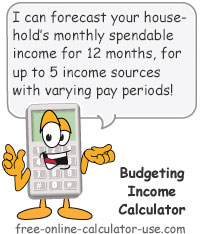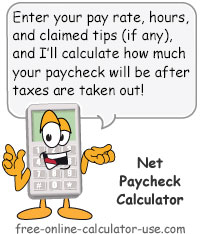IMPORTANT: Numeric entry fields must not contain dollar signs, percent signs, commas, spaces, etc. (only digits 0-9 and decimal points are allowed).
Click the Terms tab above for a more detailed description of each entry.
Step #1:
For each income source enter the name, amount, pay day frequency, and date of last pay day. Then tap the "Add" button to add the source to your list.
Step #2:
Once you are satisfied with your income source list, tap the "Show Net Income" button. This will initially display a combined monthly take-home pay chart for the next 12 months.
Step #3:
To view an individual source's 12 month pay day calendar, select the name of the income source from the drop-down menu located above the chart.
Step #4:
To print out a copy of any chart displayed, tap the "Printer Friendly Report" button to open the chart in a new window for printing.





Follow me on any of the social media sites below and be among the first to get a sneak peek at the newest and coolest calculators that are being added or updated each month.